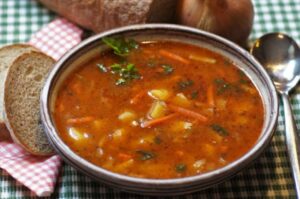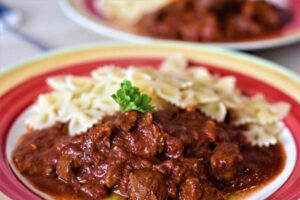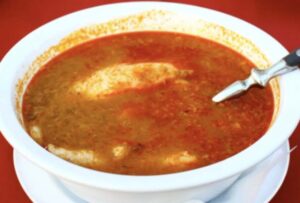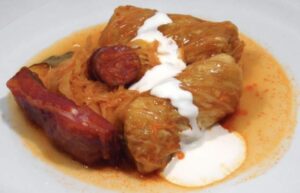Traditional Hungarian food offers a unique dining experience with various ingredients and cooking techniques. This blog post explores some of the most iconic dishes, such as goulash, pörkölt, and lángos, diving into their origins, variations, and why they are beloved staples of Hungarian gastronomy.
Goulash: The Heart and Soul of Hungarian Cuisine

Goulash, the iconic Hungarian dish
Goulash, or “gulyás” in Hungarian, is arguably the most famous dish associated with Hungary. This hearty stew, typically made with beef, potatoes, and vegetables, is flavored with an abundance of paprika, giving it its signature color and taste. The origins of goulash can be traced back to the 9th century when Magyar shepherds prepared a simple meat and vegetable stew over an open fire.
As the dish evolved, it became more complex and refined, especially in the 19th century when it gained popularity in restaurants. Goulash is often served with bread or noodles and can vary widely in terms of ingredients and preparation methods. Some versions include carrots, bell peppers, or even beans, while others may be thickened with flour or sour cream.
One of the most beloved variations is the “pörkölt” style goulash, which emphasizes a thicker consistency and may include more vegetables. In Hungary, goulash is not just a meal; it’s a social experience often enjoyed during family gatherings or festive occasions.
Pörkölt: A Hearty Stew with Depth of Flavor

Beef stew with noodles
Closely related to goulash is pörkölt, another traditional Hungarian stew essential to the country’s culinary landscape. While goulash is often soupier, pörkölt is thicker and richer, made primarily with meat—commonly beef, pork, or chicken—and a generous amount of onions. The key to a great pörkölt lies in the slow cooking process, which allows the flavors to meld beautifully.
The origins of pörkölt date back to the early days of Hungarian shepherds, who cooked their meals in a kettle over an open flame. The dish gained prominence in the 19th century, much like goulash, and has since become a staple in Hungarian households.
Pörkölt is often served with nokedli (Hungarian dumplings), rice, or potatoes, making it a hearty meal perfect for colder months. Variations of pörkölt can be found throughout Hungary, with each region adding its own twist. For example, in the southern regions, you might find pörkölt made with paprika and tomatoes, while in Transylvania, it may include mushrooms and other local ingredients.
Lángos: The Irresistible Fried Snack

Langos, Hungarian street food
Lángos is a beloved street food in Hungary, famous for its crispy exterior and soft, fluffy interior. This deep-fried flatbread is typically topped with garlic, sour cream, and cheese, although variations abound. Originating from the peasant food of ancient Hungary, lángos was once a simple dish made with basic ingredients such as flour, water, and yeast.
Today, lángos can be found at street fairs, markets, and festivals, making it a favorite among locals and tourists alike. The versatility of lángos is one of its appealing features; it can be topped with a variety of ingredients, including ham, bacon, or even sweet toppings like Nutella.
While lángos is often enjoyed as a snack, it can also serve as a main course when paired with hearty sides. The dish is a great example of how traditional Hungarian food is not just about sustenance but also about enjoyment and the celebration of flavors.
Hortobágyi Palacsinta: Savory Pancakes with a Twist

Hortobágyi palacsinta
Another iconic dish in the realm of traditional Hungarian food is hortobágyi palacsinta, which consists of savory pancakes filled with meat, then rolled and baked with a rich sauce. This dish is named after the Hortobágy region, known for its flat plains and rich agriculture.
The pancakes are typically made from a thin batter of flour, eggs, and milk, cooked to create a delicate crepe-like texture. The filling is usually made from ground meat, onions, and spices, creating a flavorful and hearty meal. Once filled and rolled, the pancakes are topped with a creamy sauce and baked until golden.
Hortobágyi palacsinta is often served as a main course and can be accompanied by a side of salad or vegetables. This dish exemplifies the Hungarian knack for taking simple ingredients and transforming them into something extraordinary.
Fisherman’s Soup (Halászlé): A Spicy Delight

Hungarian fisherman’s soup
Fisherman’s soup, or halászlé, is a dish that showcases Hungary’s love for fresh ingredients, particularly fish. This spicy soup is primarily made from freshwater fish, such as carp or catfish, and is flavored with a generous amount of paprika and tomatoes.
Halászlé has its roots in the fishing communities along the Danube River and Lake Balaton, where fishermen would use the catch of the day to create this warm, comforting dish. Traditionally, halászlé is prepared in large cauldrons over an open flame, a practice that adds to its unique flavor.
The soup is often served with fresh bread or noodles, and its vibrant red color is a testament to the generous use of paprika. Variations of halászlé can be found throughout Hungary, with each region adding its own touches, such as different types of fish or additional spices.
Töltött Káposzta: Stuffed Cabbage Rolls

Stuffed cabbage rolls
Töltött káposzta, or stuffed cabbage rolls, is another cherished traditional Hungarian dish. This hearty meal consists of cabbage leaves filled with a mixture of ground meat, rice, and spices, then simmered in a rich tomato sauce.
The origins of töltött káposzta can be traced back to the Ottoman Empire, where stuffed vegetables were common. Over time, this dish has evolved, incorporating local ingredients and flavors.
Töltött káposzta is often enjoyed during holidays and family gatherings, making it a symbol of togetherness and comfort. Each family may have its own recipe, passed down through generations, making it a deeply personal dish that varies from household to household.
Desserts: A Sweet Conclusion

Dobos torte
To truly experience traditional Hungarian food, one must also indulge in its desserts. Hungary is known for its rich and diverse range of sweets, with classic dishes like chimney cake (kürtőskalács), strudel (rétes), and dobos torte making an appearance at celebrations and gatherings.
Kürtőskalács is a sweet, spiral-shaped pastry that is baked over an open flame, coated in sugar, and often topped with nuts or cinnamon. Strudel, filled with apples or cherries, is a flaky pastry that showcases Hungary’s baking prowess. Dobos torte, a layered cake with chocolate buttercream and caramel, is a true testament to Hungary’s rich pastry traditions.
Traditional Hungarian food is a vibrant reflection of the country’s rich history and culture. From hearty stews like goulash and pörkölt to delightful snacks like lángos, each dish tells a story of the land and its people. The importance of these iconic dishes goes beyond mere sustenance; they are a celebration of flavors, family, and tradition.


0 Comments